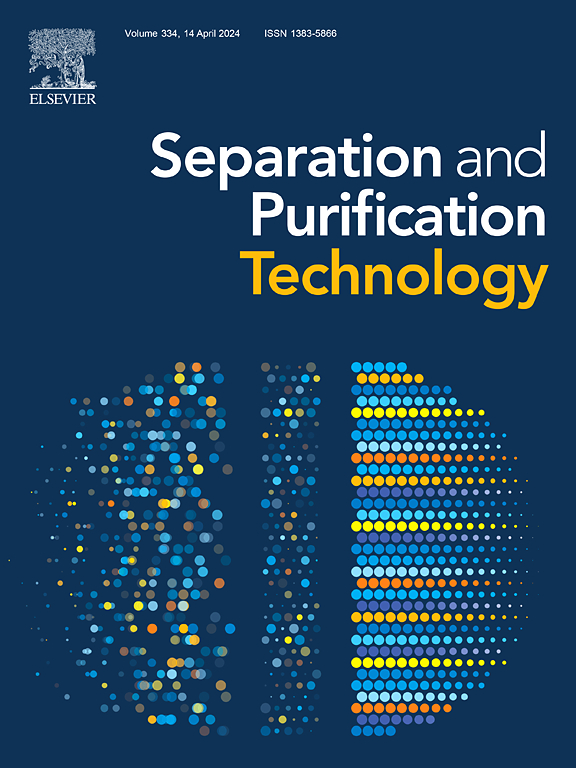Improved efficiency in conductive heating vacuum membrane distillation with polyurethane based hydrogels
IF 8.1
1区 工程技术
Q1 ENGINEERING, CHEMICAL
引用次数: 0
Abstract
Membrane distillation is an emerging desalination technique that utilizes thermal membrane coupling; however, traditional processes experience temperature polarization due to heated feed, which diminishes flux. Recent advancements in local heating technologies, such as thermally conductive vacuum membrane distillation (CH-VMD), have demonstrated potential in enhancing flux. Nevertheless, the stable structure of water molecules requires substantial heat energy for evaporation, limiting improvements in flux. To tackle this, we integrated tailored hydrogels at the thermal conducting layer-feed interface within the CH-VMD system, optimizing water evaporation and reducing its enthalpy. Three polyurethane-based hydrogels were developed and characterized. The effect of these hydrogels on water evaporation efficiency in the CH-VMD system was examined, alongside variations in flux and salt rejection across different brine concentrations, while also assessing thermal efficiency and specific energy consumption. Raman spectroscopy confirmed the presence of intermediate water in the hydrogel. Differential scanning calorimetry indicated that the hydrogel decreased water’s evaporation enthalpy by 51 %. The CH-VMD system employing hydrogels made from polyvinyl alcohol, sodium alginate, and carboxylated carbon nanotubes achieved a permeation flux of 21.4 L/m2·h when treating 3.5 wt% high-salinity water, marking a 96.2 % increase in flux, an 8.3 % rise in thermal efficiency, and a 48.2 % reduction in specific energy consumption compared to conventional CH-VMD. Even with brine concentration raised to 10 wt%, the permeate flux was 19.6 L/m2·h, achieving a rejection exceeding 99.5 %. The mechanism employs hydrogels to increase the proportion of intermediate water with weak hydrogen bonds, facilitating its escape. Additionally, the –COOH group bonds with –OH, reducing thermal resistance and enhancing heat transfer, allowing for greater heat absorption for evaporation and higher flux. These findings demonstrate that integrating hydrogels significantly enhances the CH-VMD system’s efficiency for treating high-salinity water.
求助全文
约1分钟内获得全文
求助全文
来源期刊

Separation and Purification Technology
工程技术-工程:化工
CiteScore
14.00
自引率
12.80%
发文量
2347
审稿时长
43 days
期刊介绍:
Separation and Purification Technology is a premier journal committed to sharing innovative methods for separation and purification in chemical and environmental engineering, encompassing both homogeneous solutions and heterogeneous mixtures. Our scope includes the separation and/or purification of liquids, vapors, and gases, as well as carbon capture and separation techniques. However, it's important to note that methods solely intended for analytical purposes are not within the scope of the journal. Additionally, disciplines such as soil science, polymer science, and metallurgy fall outside the purview of Separation and Purification Technology. Join us in advancing the field of separation and purification methods for sustainable solutions in chemical and environmental engineering.
 求助内容:
求助内容: 应助结果提醒方式:
应助结果提醒方式:


